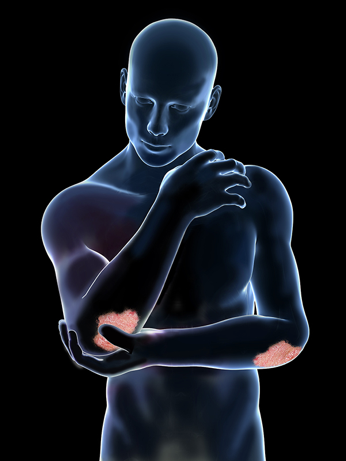
PSO is characterized by well-defined, raised plaques with silvery scales.2,3 The plaques commonly occur on the scalp; extensor surfaces such as the elbows and knees; and the lower back. Nail involvement is also common.2
The symptoms of PSO may negatively affect quality of life for people with this disease,4 increasing their risk of depression, anxiety, and suicidality vs the general population.5 Patients may also experience genital PSO, which can negatively affect many aspects of sexual health including sexual experience, frequency, and desire.6
The prevalence of PSO is approximately equal in men and women.1, Seventy-five percent of women with PSO present before the age of 40, which implies that many of them are of childbearing potential.7 Women with PSO may experience disease differently than men, with a higher prevalence of psychological and sexual distress and a higher level of stigmatization.8,9 For women with PSO who become pregnant, 21% report no change in disease activity and 23% report worsening disease activity (when measured by a physician via change in body surface area, 55% of pregnant patients with PSO have no change and 15% have worsening disease activity.)10 Furthermore, 65% of women with PSO report worsening disease activity after giving birth (when measured by a physician, 41% have worsening disease activity).10
1. Helmick CG, Lee-Han H, Hirsch SC, Baird TL, Bartlett CL. Prevalence of psoriasis among adults in the U.S.: 2003-2006 and 2009-2010 National Health and Nutrition Examination Surveys. Am J Prev Med. 2014;47(1):37-45.
2. Weller RP, Hunter JA, Savin JA, et al. Psoriasis. In: Clinical Dermatology. 4th ed. Malden, MA: Blackwell Publishing; 2008:54-70.
3. Haroon N, Ritchlin C. Mechanisms of bone remodeling in psoriatic arthritis. In: Adebajo A, Boehncke WH, Gladman DD, et al, eds. Psoriatic Arthritis and Psoriasis. Switzerland: Springer International Publishing; 2016:111-126.
4. Armstrong AW, Schupp C, Wu J, Bebo B. Quality of life and work productivity impairment among psoriasis patients: findings from the National Psoriasis Foundation survey data 2003-2011. PLoS One. 2012;7(12):e52935.
5. Kurd SK, Troxel AB, Crits-Christoph P, Gelfand JM. The risk of depression, anxiety, and suicidality in patients with psoriasis: a population-based cohort study. Arch Dermatol. 2010;146(8):891-895.
6. Cather JC, Ryan C, Meeuwis K, et al. Patients' Perspectives on the Impact of Genital Psoriasis: A Qualitative Study. Dermatol Ther (Heidelb). 2017;7(4):447-461.
7. Tauscher AE, Fleischer AB, Jr., Phelps KC, Feldman SR. Psoriasis and pregnancy. J Cutan Med Surg. 2002;6(6):561-570.
8. Colombo D, Cassano N, Bellia G, et al. Gender medicine and psoriasis. World J Dermatol. 2014;3(3):36-44.
9. Hawro M, Maurer M, Weller K, et al. Lesions on the back of hands and female gender predispose to stigmatization in patients with psoriasis. J Am Acad Dermatol. 2017;76(4):648-654.e642.
10. Murase JE, Chan KK, Garite TJ, Cooper DM, Weinstein GD. Hormonal effect on psoriasis in pregnancy and post partum. Arch Dermatol. 2005;141(5):601-606.